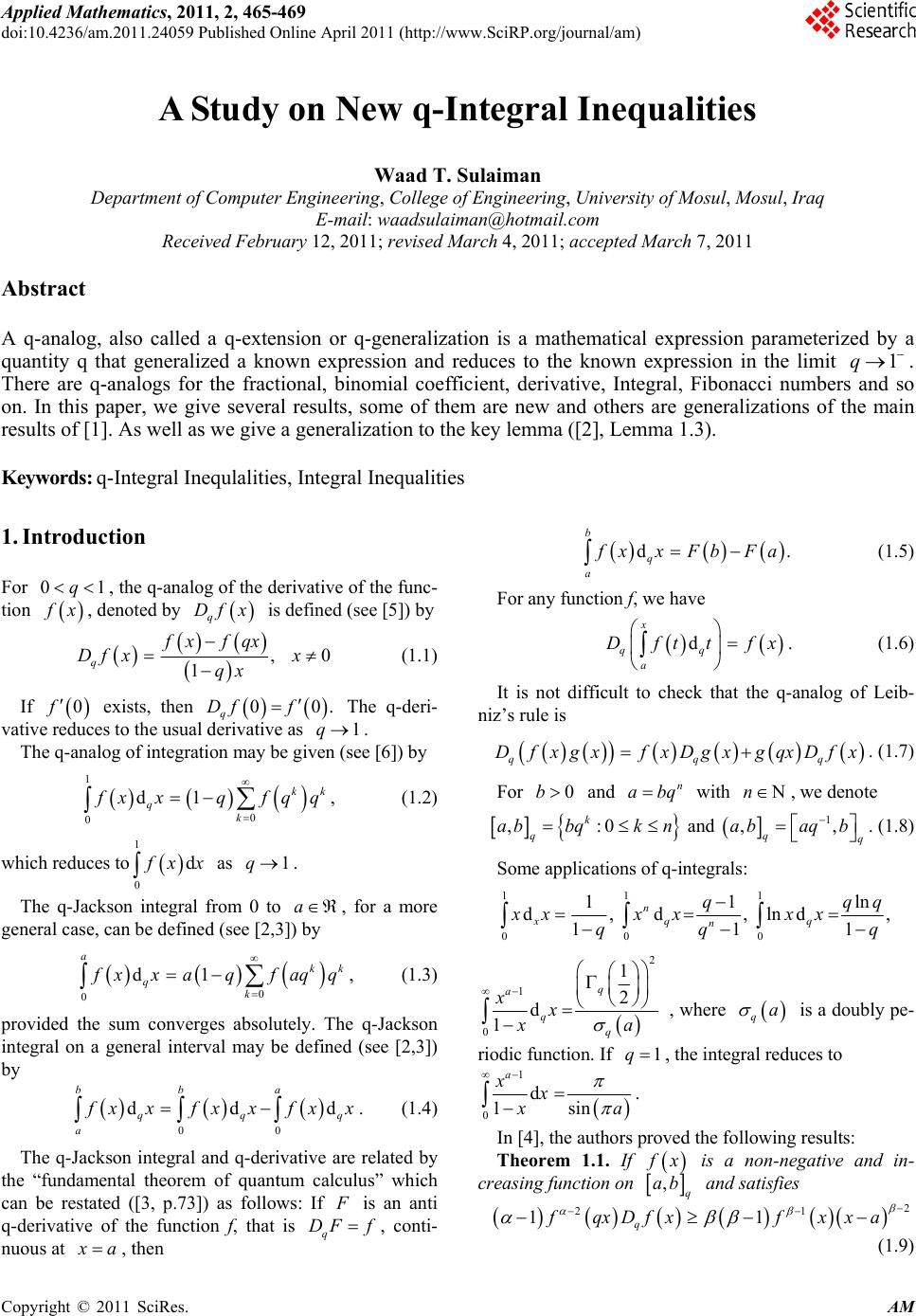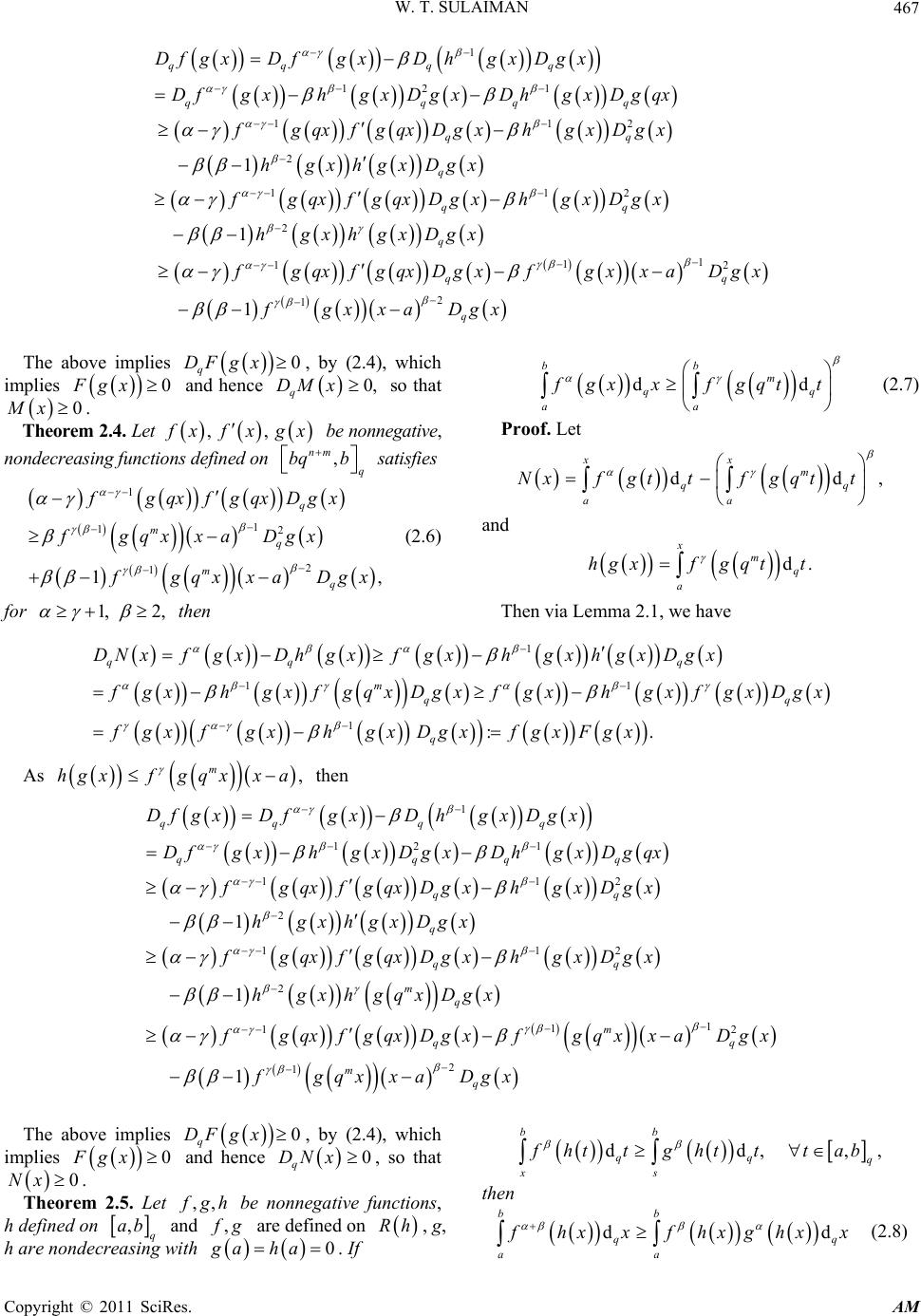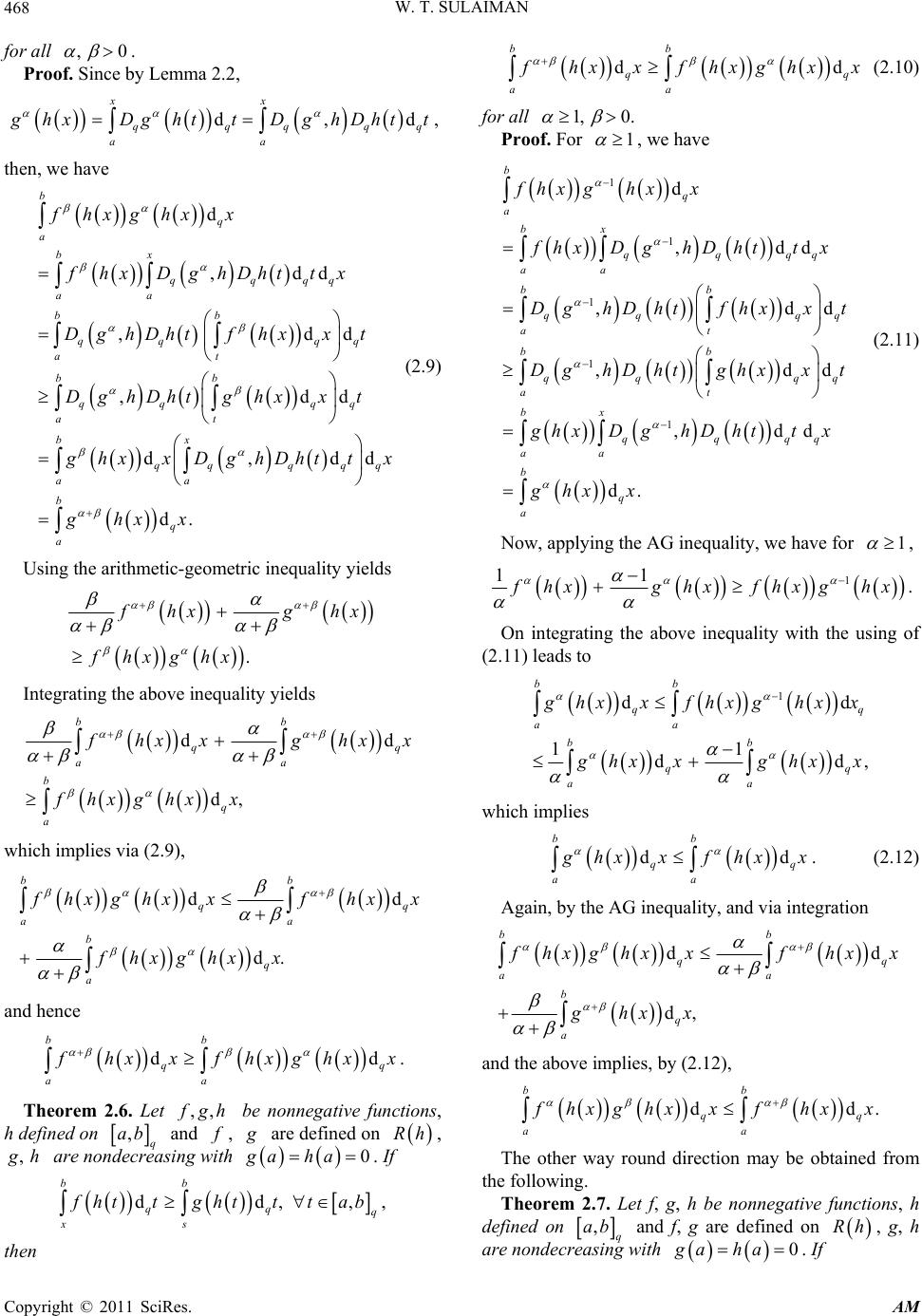Paper Menu >>
Journal Menu >>
 Applied Mathematics, 2011, 2, 465-469 doi:10.4236/am.2011.24059 Published Online April 2011 (http://www.SciRP.org/journal/am) Copyright © 2011 SciRes. AM A Study on New q-Integral Inequalities Waad T. Sulaiman Department of C om put er E ngineering, College of Engineering, University of Mosul, Mosul, Iraq E-mail: waadsulaiman@hotmail.com Received February 12, 2011; revised March 4, 2011; accepted March 7, 2011 Abstract A q-analog, also called a q-extension or q-generalization is a mathematical expression parameterized by a quantity q that generalized a known expression and reduces to the known expression in the limit 1q . There are q-analogs for the fractional, binomial coefficient, derivative, Integral, Fibonacci numbers and so on. In this paper, we give several results, some of them are new and others are generalizations of the main results of [1]. As well as we give a generalization to the key lemma ([2], Lemma 1.3). Keywords: q-Integral Inequlalities, Integral Inequalities 1. Introduction For 01q, the q-analog of the derivative of the func- tion f x, denoted b y q Df x is defined (see [5]) by ,0 1 q fx fqx Df xx qx (1.1) If 0f exists, then 00. q Df f The q-deri- vative reduces to the usual derivative as 1q. The q-analog of inte grat i o n may be given (see [6]) by 1 0 0 d1 kk qk f xxq fqq , (1.2) which reduces to 1 0 d f xx as 1q. The q-Jackson integral from 0 to a, for a more general case, can be defined (see [2,3]) by 0 0 d1 akk qk f xxa qfaqq , (1.3) provided the sum converges absolutely. The q-Jackson integral on a general interval may be defined (see [2,3]) by 00 ddd bba qqq a f xx fxxfxx . (1.4) The q-Jackson integral and q-derivative are related by the “fundamental theorem of quantum calculus” which can be restated ([3, p.73]) as follows: If F is an anti q-derivative of the function f, that is q DF f, conti- nuous at x a, then d. b q a f xxFbFa (1.5) For any function f, we have d x qq a Dfttfx . (1.6) It is not difficult to check that the q-analog of Leib- niz’s rule is qqq Df xgxf xDgxgqxDf x . (1.7) For 0b and n abq with n, we den ote 1 ,:0 and ,, k qq q a bbqkna baqb . (1.8) Some applications of q-integrals: 11 1 00 0 11ln d, d, lnd, 11 1 n xq q n qqq xxx xxx qq q 2 1 0 1 2 d 1 q a qq xx xa , where qa is a doubly pe- riodic function. If 1q , the integral reduces to 1 0 d 1sin a xx x a . In [4], the authors proved the following resu lts: Theorem 1.1. If f x is a non-negative and in- creasing function on ,q ab and satisfies 2 21 11 q fqxDfx fxxa (1.9)  W. T. SULAIMAN Copyright © 2011 SciRes. AM 466 for 1 and 1 , then dd bb qq aa f xx fxx . (1.10) Theorem 1.2. If f x is a non-negative and increa- sing function on , nm q bq b for ,mn and satisfies 2 1 11 m q Df xfqxxa (1.11) on ,q ab and for , 1 , then dd. bb m qq aa fxx fqxx (1.12) Theorem 1.3. If f x is a non-negative function on 0, q b and satisfies dd bb qq xx f ttt t (1.13) for 0, q x b and 0 , then the inequality 00 dd bb qq f tt tftt (1.14) holds for all positive numbers and . In the coming section, we start with Lemma 2.1, which represent a generalization of ([1], Lemma 1.3). Theorems 2.3 and 2.4 are generalizations of Theorems 1.1 and 1.2 respectively, while Theorem 2.5 gives a ge- neralization for more than one direction to Theorem 1.3. Other new results are also given. 2. Results Lemma 2.1. Let ,, f xfxgx be nonnegative, nondecreasing functions defined on ,q ab , and let 1.p Then 1 1. pp qq pq pfgqxfgqxD gxDfgx pfgxfgx Dgx (2.1) Proof. We have 1 1 1 1 1 d 1 d 1 1 . pp p q xp qx px qx p pq f gxfgqx Df gxqx p f gtfgtg tt qx pfg xfg xgt t qx pfg xfg x g xgqx qx pfgxfgxDgx Also, 1 1 d 1 . px p qqx pq pfg qxfg qx Dfgxg tt qx pfgqxfgqx Dgx Lemma 2.2. Define , q f gx fgqx Dfg gx gqx . (2.2) Then ,. qqq Df gxDfg Dgx (2.3) Proof. It is follows as 1 1 ,. q qq fgx fgqx Df gxqx fgx fgqx g xgqx gx gqxqx DfgDgx Theorem 2.3. Let ,, f xfxgx be nonnega- tive, nondecreasing functions defined on ,q ab satis- fies 1 1 12 2 1 1 q q q f gqxfgqxDgx fgxxaDgx f gxxaDgx (2.4) for 1 , 2 , then dd. bb qq aa f gx xfgx x (2.5) Proof. Let dd, xx qq aa M xfgttfgtt and d. x q a hgxf gtt Then via Lemma 2.1, we hav e 1 1 1 :. qq q q q DMxfg xDhgx fgxh gxhgxDgx fgxhgxfgx Dgx f gxfgxhgx Dgx fgxFgx As ,hgxfgxxa then  W. T. SULAIMAN Copyright © 2011 SciRes. AM 467 1 12 1 112 2 112 2 1 1 1 qqqq qqqq qq q qq q q DfgxDfgxD hgx Dgx Dfgxhgx DgxDhgx Dgqx fgqxfgqxDgxhgxDgx hgxhgxDgx fgqxfgqxDgxhgxDgx hgxhgxDgx fgqxfgqxD 1 12 2 1 1 q q g xf gxxaDgx fgxxaDgx The above implies 0 q DFg x, by (2.4), which implies 0Fgx and hence 0, q DM x so that 0Mx. Theorem 2.4. Let ,, f xfxgx be nonnegative, nondecreasing functions defined on , nm q bq b satisfies 1 1 12 2 1 1, q mq mq fg qxfgqxDg x fgqxxaDgx f gqxxaDgx (2.6) for 1, 2, then dd bb m qq aa f gxxf gqtt (2.7) Proof. Let dd, xx m qq aa Nxfgt tfgqt t and d. xmq a hgxf gqtt Then via Lemma 2.1, we hav e 1 1 1 1:. qq q mqq q DNxf gxDhgxf gxhgxhgxDgx f gxhgxfgqxDgxfgxhgxfgx Dgx fgxfgxhgxDgxfgx Fgx As , m hgxfgqxxa then 1 12 1 112 2 112 2 1 1 1 qqqq qqqq qq q qq mq DfgxDfgxD hgx Dgx Dfgxhgx DgxDhgx Dgqx fgqxfgqxDg xhg xDg x hgxhgxDgx fgqxfgqxDg xhg xDg x hgxhgqxDgx fgqxfgq 1 12 2 1 1 m qq mq x Dg xfgq xxaDg x fgqxxaDgx The above implies 0 q DFg x, by (2.4), which implies 0Fgx and hence 0 q DN x , so that 0Nx. Theorem 2.5. Let ,, f gh be nonnegative functions, h defined on ,q ab and , f g are defined on Rh, g, h are nondecreasing with 0ga ha. If dd,,, bb qq q xs f httg htttab then dd bb qq aa f hx xfhxghx x (2.8)  W. T. SULAIMAN Copyright © 2011 SciRes. AM 468 for all ,0 . Proof. Since by Lemma 2.2, d,d xx qqqqq aa g hxDghttD g hDhtt , then, we have d ,dd ,dd ,dd d,dd d. b q a bx qqqq aa bb qq qq at bb qq qq at bx qq qqq aa b q a fhxghx x fhx DghDhttx DghDhtf hxxt DghDhtg hxxt g hxxD g hDhttx ghxx (2.9) Using the arithmetic-geometric inequality yields . f hxg hx fhxghx Integrating the above inequality yields dd d, bb qq aa b q a f hx xghx x fhxghx x which implies via (2.9), dd d. bb qq aa b q a f hxghxxf hxx fhxghx x and hence dd bb qq aa f hx xfhxghx x . Theorem 2.6. Let ,, f gh be nonnegative functions, h defined on ,q ab and f , g are defined on Rh, , g h are nondecreasing with 0ga ha. If dd,,, bb qq q xs f httghtttab then dd bb qq aa f hx xfhxghx x (2.10) for all 1, 0. Proof. For 1 , we have 1 1 1 1 1 d ,dd ,dd ,dd ,dd d. b q a bx qqqq aa bb qq qq at bb qq qq at bx qqqq aa b q a fhx ghxx fhxDghD httx DghDhtfhxx t DghDhtghxxt ghxD ghDhttx ghxx (2.11) Now, applying the AG inequality, we have for 1 , 1 11 f hxghxf hxghx . On integrating the above inequality with the using of (2.11) leads to 1 dd 11 dd, bb qq aa bb qq aa g hxxf hxghxx g hx xghx x which implies dd bb qq aa g hx xfhx x . (2.12) Again, by the AG inequality, and via integration dd d, bb qq aa b q a f hxghxxf hxx ghxx and the above implies, by (2.12), dd. bb qq aa f hxghxxf hxx The other way round direction may be obtained from the following. Theorem 2.7. Let f, g, h be nonnegative functions, h defined on ,q ab and f, g are defined on Rh, g, h are nondecreasing with 0ga ha. If  W. T. SULAIMAN Copyright © 2011 SciRes. AM 469 dd,,, bb qq q xs f httghtttab then dd bb qq aa f hx xfhxghx x (2.13) for all 0 . Proof. We have, via Lemma 2.2, d ,dd ,dd ,dd d,dd d. b q a bx qqqq aa bb qq qq at bb qq qq at bx qq qqq aa b q a fhxg hxx fhx DghDhttx DghDhtf hxxt DghDhtghxxt g hxxD ghDhttx ghxx (2.14) Making use of the AG i neq uality, . f hxg hx fhxg hx Integrating the above inequality, with making use of (2.14) yield dd d d d d. bb qq aa b q a b q a b q a b q a f hx xghx x fxghx x fxghx x fxghx x fxghx x 3. References [1] Y. Miao and F. Qi, “Several q-Integral Inequalities,” Journal of Mathematical Inequalities, Vol. 3, No. 1, 2009, pp. 115-121. [2] K. Brahim, N. Bettaibi and M. Sellemi, “On Some Feng Qi Type q-Intagral Inequlities,” Pure Applied Mathemat- ics, Vol. 9, No. 2, 2008, Art. 43. [3] E. W. Weisstein, “q-Derivative,” Math World-A Wol- fram Web Resource,” 2010. http://mathword. Wolfram .com/q-Derivative.html [4] E. W. Weisstein, “q-Integral,” Math World-A Wolfram Web Resource,” 2010. http://mathword. Wolfram .com/q-integral.html [5] F. H. Jackson, “On q-Definite Integrals,” Pure Applied Mathematics, Vol. 41, No. 15, 1910, pp. 193-203. [6] V. Kac and P. Cheung, “Quantum Calculus,” Universitext, Springer-Verlag, New York, 2003. |

